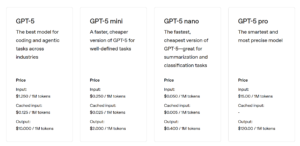What Are ChatGPT Tokens And How Much Do They Cost?
A Guide To Tokens
What is an LLM token?
The difference between tokens vs. words
A token is a small chunk of text the model processes, not quite a character and not quite a word (which is why it’s often hard to visualize). A short word like “cat” might be just one token, while something longer like “extraordinary” could take several. Even punctuation, spaces, and emojis count toward the total. A helpful rule of thumb: in English, one token is roughly four characters or about three quarters of a word. That means 100 tokens is about 75 words, and 1,000 tokens is about 750 words. This varies with formatting and language, but it is close enough for quick estimates.
You might wonder why AI uses tokens rather than words. Here are a few of the reasons.
Words are inconsistent.
Words vary wildly in length and form. “A,” “antidisestablishmentarianism,” and “😊” are all single words, but not equally sized units of information. Tokenization breaks text into smaller, more uniform pieces so the model can handle them efficiently.Models need predictable input sizes.
Neural networks work on fixed-length sequences. By converting text into tokens (which might represent whole words, syllables, or even parts of words), the model can process any language or format within a consistent framework.Supports many languages and scripts.
English spaces neatly between words, but languages like Chinese or Japanese don’t. Tokens make it possible to process all languages the same way; each token just maps to a number, no matter how the original text looks.Improves memory and performance.
Counting tokens rather than words allows LLMs to allocate memory precisely, ensuring predictable limits (like “up to 200,000 tokens of context”) across all users and use cases.
Input, output, and reasoning tokens
In an API workflow you are billed for three things. Input tokens are everything you send to the model: your instructions, policies, and the source text you want it to read. Output tokens are what the model returns, such as a drafted email or a summary. Some providers also account for reasoning tokens, which represent extra “think time” on tougher problems. You do not usually see those internal steps, but they can count toward usage on certain models.
Typical token counts for everyday business documents
Use these quick ballparks when planning a workflow. Real counts vary with language, formatting, and how much instruction text your prompts carry, but these are close enough for budgeting.
- Short business email around 150 to 200 words: about 200 to 270 tokens including brief instructions.
- One page of plain prose around 400 words: about 530 tokens.
- Simple invoice details with a few line items and addresses: 250 to 500 input tokens and 300 to 400 output tokens if you generate a formatted invoice.
- 10 page legal contract with dense text around 4,000 words: 5,300 to 6,000 input tokens before instructions and output.
How much ChatGPT tokens cost

Every provider prices differently, although they generally fall in a similar range. As a rule of thumb, OpenAI’s current API sheet for the GPT‑5 family, shown at left, highlights differences between more and less powerful models:
- GPT‑5 nano: input $0.05 per 1M tokens, output $0.40 per 1M.
- GPT‑5 mini: input $0.25 per 1M tokens, output $2.00 per 1M.
- GPT‑5: input $1.25 per 1M tokens, output $10.00 per 1M.
- GPT‑5 pro: input $15.00 per 1M tokens, output $120.00 per 1M.
Some tiers also offer a lower cached input rate when you reuse the same long instructions across many calls.
Real‑world examples: comparison of human labor vs. AI token cost
Below are three common tasks. To keep comparisons clean, we assume the same token counts across models.
- Email: read and reply 400 input tokens to read the message and your policy, 200 output tokens for a reply.
- Legal contract: summarize 10 dense pages 6,000 input tokens for the document and instructions, 3,000 reasoning tokens, 800 output tokens for a concise summary.
- Invoice: create from details 500 input tokens for the order data, 350 output tokens for a formatted invoice.
Cost formula (input × input rate + output × output rate + reasoning × output rate) ÷ 1,000,000
| Task | Input | Output | Reasoning | GPT‑5 nano | GPT‑5 mini | GPT‑5 | GPT‑5 pro | Human time | $20/hr | $50/hr | $100/hr |
|---|---|---|---|---|---|---|---|---|---|---|---|
| Email: read and reply | 400 tok | 200 tok | 0 tok | 0.01¢ | 0.050¢ | 0.250¢ | 3.000¢ | ~5 min | $1.67 | $4.17 | $8.33 |
| Legal: summarize 10 page contract | 6,000 tok | 800 tok | 3,000 tok | 0.18¢ | 0.910¢ | 4.550¢ | 54.600¢ | ~60 min | $20.00 | $50.00 | $100.00 |
| Invoice: create from details | 500 tok | 350 tok | 0 tok | 0.017¢ | 0.083¢ | 0.413¢ | 4.950¢ | ~10 min | $3.33 | $8.33 | $16.67 |
Several things jump out from this data. First, smaller models like nano or mini handle high volume, repeatable tasks at a tiny cost. If you plan to process extremely large volumes, more advanced steps such as batching could be taken to reduce costs, but for most small businesses, this may not be worth the effort.
However, overall, costs are so low that we often choose in practice to use higher-quality models for our own workflows. The most expensive AI task in this example – summarizing a 10 page legal contract – costs roughly 50 cents. Even at $20 per hour, human labor would exceed this cost within a few minutes – hardly enough time to even start to understand a lengthy legal document.
A quick note on platform fees

If you build your automations via common platforms like Zapier, Make, and n8n, these platforms have their own pricing (either per action/module or per workflow run) that is separate from AI token usage.
Conclusion
We hope this overview of the cost of ChatGPT tokens helps you understand how you would actually be charged. We can help design token-efficient automations that plug into the tools you already use. We like to start with one valuable use case, then expands once you see the results. If you want a quick conversation about your workflow, contact us. For more practical guides, join our mailing list. If this article helped, follow us on X and LinkedIn, and share it with a friend.
FAQ
Are Gemini tokens or Claude tokens the same as ChatGPT tokens?
How can I estimate cost before I build?
When should I use a pro model instead of mini or nano?
What about consumer plan limits?
Sources
- OpenAI Pricing. https://openai.com/api.pricing
- OpenAI Help: Tokens and counting basics. https://help.openai.com/en/articles/4936856-what-are-tokens-and-how-to-count-themhttps://help.openai.com/
Numbers in the tables are estimates for planning, not promises. Always verify current pricing and test with your own documents and prompts.





